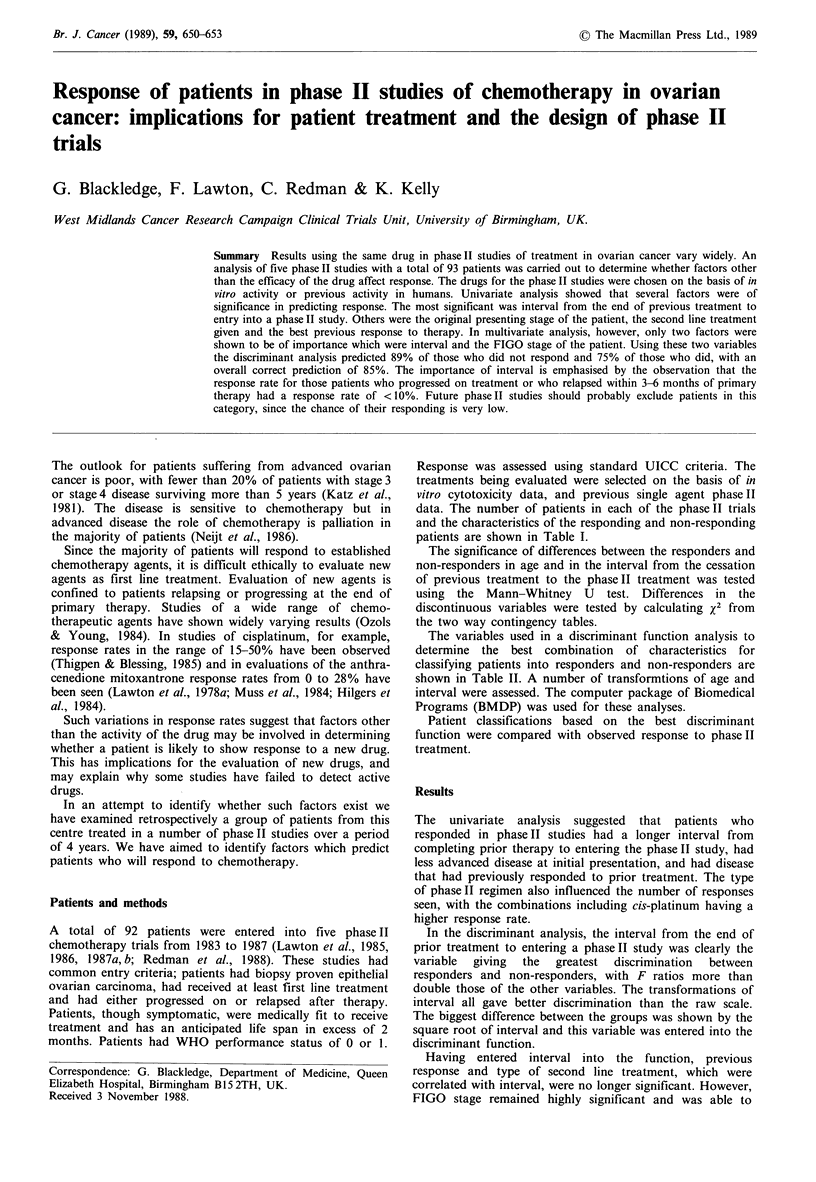Abstract
Results using the same drug in phase II studies of treatment in ovarian cancer vary widely. An analysis of five phase II studies with a total of 93 patients was carried out to determine whether factors other than the efficacy of the drug affect response. The drugs for the phase II studies were chosen on the basis of in vitro activity or previous activity in humans. Univariate analysis showed that several factors were of significance in predicting response. The most significant was interval from the end of previous treatment to entry into a phase II study. Others were the original presenting stage of the patient, the second line treatment given and the best previous response to therapy. In multivariate analysis, however, only two factors were shown to be of importance which were interval and the FIGO stage of the patient. Using these two variables the discriminant analysis predicted 89% of those who did not respond and 75% of those who did, with an overall correct prediction of 85%. The importance of interval is emphasised by the observation that the response rate for those patients who progressed on treatment or who relapsed within 3-6 months of primary therapy had a response rate of less than 10%. Future phase II studies should probably exclude patients in this category, since the chance of their responding is very low.
Full text
PDF



Selected References
These references are in PubMed. This may not be the complete list of references from this article.
- Hilgers R. D., Rivkin S. E., Von Hoff D. D., Alberts D. S. Mitoxantrone in epithelial carcinoma of the ovary. A Southwest Oncology Group study. Am J Clin Oncol. 1984 Oct;7(5):499–501. doi: 10.1097/00000421-198410000-00020. [DOI] [PubMed] [Google Scholar]
- Lawton F. G., Perren T. J., Luesley D. M., Meanwell C. A., Chan K. K., Mould J. J., Blackledge G. Combination of bleomycin and mitomycin after failure of cisplatin and alkylating agent therapy in epithelial ovarian cancer. Cancer Treat Rep. 1986 Apr;70(4):525–526. [PubMed] [Google Scholar]
- Lawton F., Blackledge G., Mould J., Latief T., Watson R., Chetiyawardana A. D. Phase II study of mitoxantrone in epithelial ovarian cancer. Cancer Treat Rep. 1987 Jun;71(6):627–629. [PubMed] [Google Scholar]
- Muss H. B., Asbury R., Bundy B., Ehrlich C. E., Graham J. Mitoxantrone (NSC-301739) in patients with advanced ovarian carcinoma. A phase II study of the Gynecologic Oncology Group. Am J Clin Oncol. 1984 Dec;7(6):737–739. doi: 10.1097/00000421-198412000-00026. [DOI] [PubMed] [Google Scholar]
- Neijt J. P., ten Bokkel Huinink W. W., Van der Burg M. E., van Oosterom A. T. Complete remission at laparotomy: still a gold standard in ovarian cancer? Lancet. 1986 May 3;1(8488):1028–1028. doi: 10.1016/s0140-6736(86)91290-0. [DOI] [PubMed] [Google Scholar]
- Ozols R. F., Young R. C. Chemotherapy of ovarian cancer. Semin Oncol. 1984 Sep;11(3):251–263. [PubMed] [Google Scholar]


